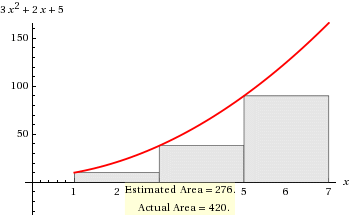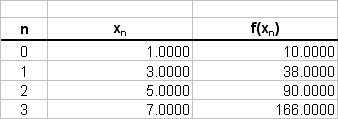How do you calculate the left Riemann sum for the given function over the interval [1,7], using n=3 for #(3 x^2+2 x +5) #?
2 Answers
588 (Using a right Riemann sum, oops)
Explanation:
I just realized the actual question was for a left Riemann sum, not a right one. Pardon my mistake. Below is the procedure for evaluating it with a right Riemann sum:
The general formula for a right-sided rectangle Riemann approximation on the interval
where
Plugging in the numbers, we get:
We can multiply out the
Now, let's evaluate it:
So, a
We can compare this to the actual answer, which would be computed using the anti-derivative:
If we look at the difference, we get
# LRS = 276 #
Explanation:
Let:
# f(x) = 3x^2+2x+5 #
We want to estimate
# Deltax = (7-1)/3 = 2#
Note that we have a fixed interval (strictly speaking a Riemann sum can have a varying sized partition width). The values of the function are tabulated as follows;
Left Riemann Sum

# LRS = sum_(r=0)^2 f(x_i) \ Deltax_i #
# " " = 2 * (10 + 38 + 90) #
# " " = 2 * (138) #
# " " = 276 #
Actual Value
For comparison of accuracy:
# Area = int_1^7 \ 3x^2+2x+5 \ dx #
# " " = [x^3+x^2+5x]_1^7 #
# " " = (343+49+35) - (1+1+5)#
# " " = 427-7#
# " " = 420#



